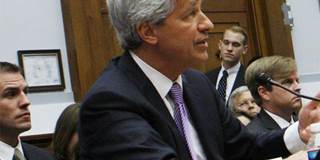Nearly seven years after the global financial crisis erupted, and more than five years after the passage of the Dodd-Frank financial-reform legislation in the US, the cause of the crisis – banks that are “too big to fail” – has yet to be uprooted. As long as that remains the case, another disaster is only a matter of time.
WASHINGTON, DC – Nearly seven years after the global financial crisis erupted, and more than five years after the passage of the Dodd-Frank financial-reform legislation in the United States, the cause of the crisis – the existence of banks that are “too big to fail” – has yet to be uprooted. As long as that remains the case, another disaster is only a matter of time.

WASHINGTON, DC – Nearly seven years after the global financial crisis erupted, and more than five years after the passage of the Dodd-Frank financial-reform legislation in the United States, the cause of the crisis – the existence of banks that are “too big to fail” – has yet to be uprooted. As long as that remains the case, another disaster is only a matter of time.